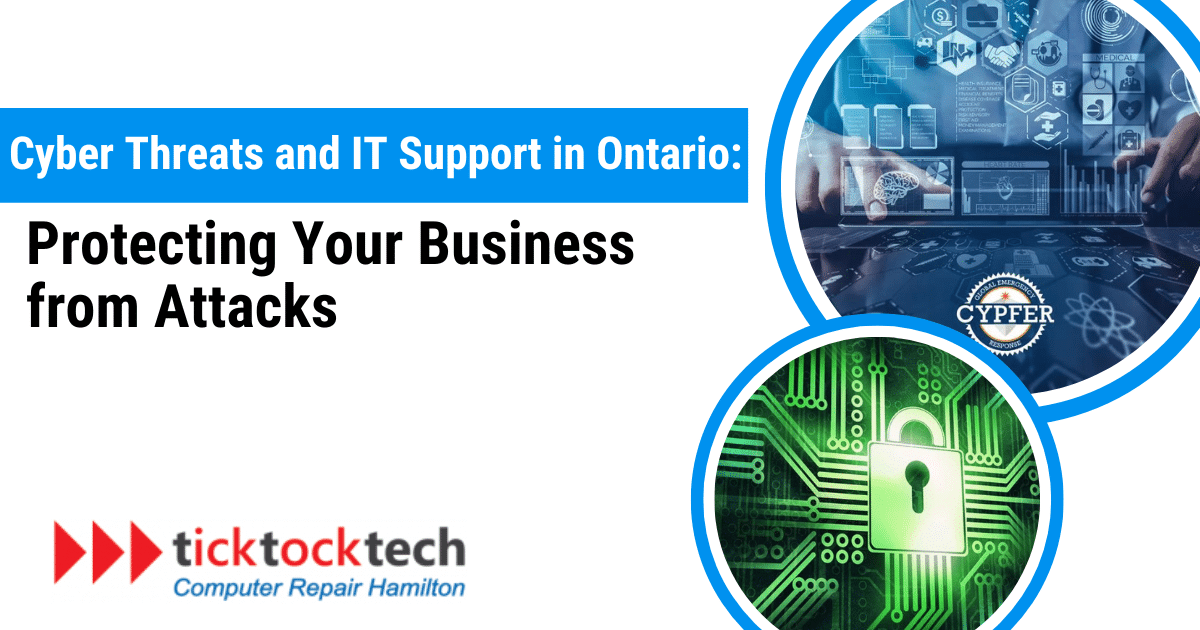Technology’s rapid advancement in today’s digital age has transformed how businesses operate. This rapid advancement also increases the risk of cyber threats. From streamlined communication to enhanced productivity, the benefits of technology are numerous. However, with these advantages come new challenges, primarily in cyber threats. Protecting your business from these threats is paramount; a robust IT support system is essential to your defense strategy. In this article, we will explore the evolving landscape of cyber threats and the critical role that IT support plays in safeguarding your business.
The Evolving Landscape of Cyber Threats
With the implementation of the implementation of proper precautions to prevent cyber threats, they can significantly positively impact your business.They have evolved substantially over the past few decades, becoming more sophisticated, pervasive, and damaging. Businesses of all sizes and across all industries are vulnerable to these threats, which can result in financial losses, reputational damage, and regulatory consequences. Here are some of the prominent cyber threats businesses face today:
1. Malware attacks
Malware, short for malicious software, is a broad category of cyber threats that includes viruses, worms, Trojans, ransomware, and spyware. They infiltrates systems through various means, often exploiting vulnerabilities in outdated software or tricking users into downloading infected files. Once inside a network, malware can cause extensive damage, from data breaches to system disruptions.
2. Phishing attacks
Phishing attacks involve tricking individuals into revealing sensitive information, such as login credentials or financial details, by posing as trustworthy entities. These attacks can occur via email, social media, or other forms of communication. Cybercriminals use cleverly crafted messages and websites to deceive users into divulging their data.
3. Denial of Service (DoS) attacks
DoS attacks aim to disrupt a business’s online operations by overwhelming its servers and network resources with excessive traffic. It can lead to service outages, downtime, and financial losses. Distributed Denial of Service (DDoS) attacks, a more potent variant, involve multiple compromised devices working in unison to amplify the impact.
4. Insider threats
Not all threats come from external actors. Insider threats can be equally damaging. These may involve current or former employees, contractors, or business partners intentionally or unintentionally compromising security. Insider threats can range from data theft to leaking sensitive information.
5. Zero-Day Exploits
Zero-day exploits target vulnerabilities in software or hardware that are not yet known to the vendor or the public. Cybercriminals use these vulnerabilities before a patch or fix is available, making them challenging to defend against.

6. Ransomware attacks
Ransomware attacks have surged in recent years. These attacks involve encrypting a business’s data and demanding a ransom for the decryption key. Paying the ransom is not advisable, as it does not guarantee the safe return of data and may even encourage further attacks.
The Role of IT Support in Cybersecurity
Given the ever-evolving nature of cyber threats, businesses must have a robust cybersecurity strategy to protect their assets, customers, and reputation. IT support is a critical component of this strategy. Here’s how IT support plays a pivotal role in safeguarding your business from cyberattacks:
1. Regular software updates and patch management
One of the most common entry points for cybercriminals is exploiting vulnerabilities in outdated software. IT support teams are responsible for ensuring that all software and hardware within your organization are up to date. Regular updates and patch management help close known security holes, making it more challenging for cybercriminals to gain access.
2. Network security and intrusion detection
IT support teams set up and maintain robust network security measures, including firewalls, intrusion detection, and intrusion prevention systems. These defenses help safeguard your network from unauthorized access and suspicious activities. Backing up your business’s data will increase the likelihood that, with cyber threats, complete data recovery is inevitable. Encryption of sensitive data can help prevent hackers from accessing your information. Detecting and responding to suspicious activity in real time can help prevent a cyber attack before it causes significant damage.
3. Email security and phishing prevention
Email is a common vector for phishing attacks. IT support can implement email filtering and security protocols to reduce the likelihood of phishing emails reaching your employees’ inboxes. It helps protect your organization from falling victim to social engineering attacks.
4. Backup and disaster recovery
IT support is crucial in setting up and managing backup and disaster recovery systems. In the event of a cyberattack, having secure backups can be a lifesaver. Having a reliable backup plan is also a method of protecting your business from cyber threats. It will enable you to recover lost or deleted data and minimize the impact of any cyber-attack. These backups allow you to restore your data and systems, minimizing downtime and financial losses in the event of a data breach.
5. Employee training and awareness
A well-informed workforce is a significant line of defense against cyber threats. IT support teams can provide cybersecurity training to employees, educating them on recognizing and responding to potential threats. This proactive approach helps prevent successful attacks and reduces the risk of data breaches.IT support teams also assist in setting up policies so the employees know what practices are acceptable or not.
6. Incident response and recovery
No security system is foolproof, and breaches can occur. IT support teams are always ready to respond swiftly and effectively. They can investigate the incident, contain the breach, and recover lost data. A well-defined incident response plan is essential for minimizing the damage and learning from the incident.
7. Security audits and compliance
IT support teams can conduct regular security audits to identify vulnerabilities and areas that need improvement. This security audit will identify vulnerabilities and weaknesses that, if left unchecked, could lead to a security breach. It will also help you determine your cybersecurity measures’ effectiveness and identify any gaps that need quick attention. Compliance with industry and government regulations is also vital. Failure to meet these standards can result in severe penalties and legal consequences.
Choosing the Right IT Support Partner
Selecting the right IT support partner is essential for ensuring the effectiveness of your cybersecurity measures. Consult with a qualified IT support provider for specific information and recommendations tailored to your business. Here are some key factors to consider when choosing an IT support provider:
1. Experience and expertise
Look for an IT support provider with a track record of delivering cybersecurity solutions and support. Experience and expertise in handling a variety of cyber threats is crucial.
2. Customized solutions
Every business has unique needs and vulnerabilities. Choose an IT support partner with tailored solutions to address your security concerns.
3. 24/7 availability
Cyber threats don’t operate on a 9-to-5 schedule. A valuable asset is a responsive IT support team that can provide round-the-clock monitoring and assistance.
4. Scalability
As your business grows, your IT support needs will evolve. Ensure your chosen partner can scale their services to meet your changing requirements.
5. Strong communication
Effective communication between your team and your IT support partner is critical. They should be able to explain complex technical concepts in a way that non-technical staff can understand.
6. Cost-effectiveness
Cybersecurity is an investment in the protection of your business. While cost is a factor, it should not be the sole determining factor. Consider the value and effectiveness of the services offered.
7. Reputation and references
Check references and reviews to get a sense of the provider’s reputation. Ask for case studies or examples of their successful cybersecurity implementations.
FAQs
Q: What are cyber threats, and why should businesses be concerned?
Cyber threats refer to malicious activities and attacks in the digital realm, targeting computer systems, networks, and data. Businesses should be concerned about these threats because they can result in financial losses, damage to reputation, and legal consequences. Protecting against cyber threats is essential to ensure the security and continuity of business operations.
Q: How can IT support help protect a business from cyber threats?
IT support helps protect businesses from cyber threats by implementing and managing security measures, including software updates, network security, email filtering, employee training, backup and disaster recovery, incident response, and compliance with cybersecurity regulations.
Q: What should businesses do if they experience a cyberattack despite having IT support in place?
If a business experiences a cyberattack, the IT support team should follow an incident response plan, which includes identifying and containing the breach, recovering lost data, and investigating the incident to prevent future occurrences. Reporting the incident to relevant authorities and stakeholders may also be necessary.
Conclusion
In the digital age, businesses face an ever-increasing array of cyber threats that can have devastating consequences. The role of IT support in protecting your business from these threats is crucial. IT support teams help safeguard your data, systems, and reputation by providing a comprehensive cybersecurity strategy.
Invest in experienced IT support that offers tailored solutions, 24/7 availability, and scalability to protect your business effectively. By choosing the right IT support partner and implementing best practices for cybersecurity, you can reduce the risk of falling victim to cyberattacks and ensure the continued success of your business in the digital era. Remember, proactive measures are the best defense in cybersecurity against evolving cyber threats.

